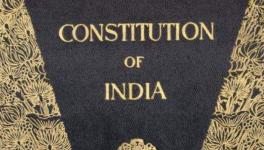What Aligarh Muslim University Means to Muslims and India
Recently, Aligarh Muslim University (AMU) completed one hundred years as a central university. Originally established by Sir Syed Ahmad Khan as the Muhammadan Anglo-Oriental College in 1875, it became Aligarh Muslim University in 1920 by an Act of Parliament.
While the celebrations this year were marked mostly with news of the time capsule launched by AMU, what was not mentioned is how central the university has become to Muslim interests in India. It has had an enormous impact on the Muslim psyche, chiefly for its phenomenal contributions to Muslim polity and education for over a century.
The university is also an emotional issue, an especially potent one since the last few decades. Muslims are attached to the AMU like no other institution, not even Delhi’s Jamia Millia Islamia, which was established after Mahatma Gandhi’s called for a boycott of government-funded institutions during the Non Cooperation Movement. AMU was only partially funded by the government, yet, captivated by the freedom movement, hundreds of students left it and launched Jamia from a rundown building in Aligarh. Recall that AMU was set up merely eight years after the 1857 Mutiny. This variegated history should shed some light on why, whenever its minority character is made a debating point, Muslims always rally behind AMU.
As a top educational institution, AMU attracts students from across the country today; not just Muslim scholars, but students from every community. A recent survey by India Today magazine ranked it the third-best Indian university. AMU offers more than 300 courses in traditional and modern fields, and is an institute of national importance, falling under the Seventh Schedule of the Constitution. This is a far cry from its humble beginnings at a time when the Muslims and the nation as a whole were suffering from a sense of loss after the massive destruction after the first war of independence. Syed had such a dedicated band of supporters that when he left government service and arrived in Aligarh, the Nawab, Samiullah Khan, had already established a school to welcome him.
At the close of the 18th century, Indian Muslim society presented a sad spectacle of inertia and degeneration. In the twilight of the Mutiny, by and large, the Muslims in much of North India had been politically and economically ruined. The rude jolt of the shift from power to powerlessness, from Bengal and Lucknow to Mysore and Madras, had left Muslim society shrouded in a time warp, unable to comprehend the present and fearful of the future. A dread of the unknown prevailed as the sudden decline was hard to bear, made worse by the ignorance, conservatism and traditionalism that then prevailed among Muslims. The lack of modern education further weakened the very foundations of their identity and brought Muslim society to the verge of collapse.
In this context, the Aligarh Movement, which pushed for modern education for Indian Muslims was nothing short of revolutionary daredevilry. Syed launched a modern educational institution which hired a large number of teachers from the top educational institutions of England for he had been mightily impressed by England’s Oxford and Cambridge universities, which he dreamed of emulating at an institution managed by Muslims in India.
AMU offered a confluence of the best of the East and the West. Top Islamic scholars such as Maulana Altaf Husain Hali, Muhsin al-Mulk and Allama Shibli Numani and scholars from Oxford and Cambridge such as T Beck, Morison and Arnold taught students, many while living on campus. The university created an atmosphere which was unique not only in India but across the so-called Muslim world.
Many people in Syed’s close circle were not very convinced of the need to import teachers from England for the nascent college that faced funds shortage from the word go. Raising the funds to run such a world class college was a huge challenge. Altaf Husain Hali writes in his biography of Syed, “Hayat-e-Javed”, that his relations with friends and relatives was based on their support for the college he was planning. If a friend or relative did not fund the Muhammadan Anglo-Oriental College, he would have no truck with him no matter how close he was.
When Syed went to Hyderabad seeking funds, a high-ranking Nizam official offered to throw a garden party for him and other dignitaries. Syed asked him to donate what he would spend on a party on his college instead. The official said he would organise the party and donate to the college. Determined, Syed responded that the official should add to the donation what he planned to spend on the party. The official grudgingly gave him Rs.1,000, a princely sum for the time.
AMU despite being a Muslim project single-handedly built by Syed Ahmad Khan, it was open for all from the first day. One of its alumni, Raja Mahendra Pratap Singh who went on to become the President of the first provisional government of India in exile in Kabul was among its earliest students. He and many other Hindu rajas donated huge tracts of lands and large sums of money towards the construction of the Muhammadan Anglo-Oriental College. The Maharaja of Darbhanga, for instance, was a key philanthropist who donated huge funds for the newly-established institute. In fact, some of its biggest donors were Hindu rajas and nawabs. This included a princely sum of Rs.60,000 from Raja Shambhu Narayan of Banaras and Rs.58,000 from Mahamdar Singh Mahamdar Bahadur of Patiala. In this sense both Hindus and Muslims built and nurtured AMU from the very beginning.
Despite an effort to create undue controversy surrounding AMU and its minority character, Ali Nadeem Rezavi, a professor of history at AMU who also studied there, says, “I think AMU has been a mixed bag. Yes, in certain aspects it did achieve what it had set out to, spread education, but we must also recognise where we lag behind, or we cannot improve.”
While AMU has helped uplift a large number of Muslims, yet the backwardness of the community is of such a magnitude that advancement appears a hopeless task! In essence, the Herculean task to uplift a community is beyond any one institution. “We did something—though much more needs to be done,” says Rezavi.
There is no denying what Rezavi then adds—that along with its successes, AMU has also got innumerable enemies today. “To forge ahead, we have to deal with the enemy within first,” he quips. What he means is that those who hanker after political patronage and power “sell their souls to those who sit outside, wishing for AMU to fail”. “Every teacher has to be a teacher, and every student, a seeker of knowledge! If we, instead of sectarian, communal and status concerns, concentrate only on knowledge acquisition, we may be able to pull through another hundred years with our flag flying,” says Rezavi.
It is therefore surprising to see the students of AMU being demonised like no one else. When AMU students supported the anti-CAA movement, their protest was brutally suppressed by the state administration—and few, if any, really came out in their support. To see the students of one of the finest educational institutions alone and feeling humiliated was a distressing sight to say the least.
Despite the great achievements of AMU, it is a sad truth that Muslims have abysmally failed to live up to the vision of its founders. Instead of building more such institutions, the leaders of the community sat still, eulogising Sir Syed and trying to protect the institution he built 145 years ago. New institutions modeled on AMU’s vision would have benefited the community and the country much more. Perhaps Muslims were in a time warp for very long, and focused on religious education imparted at madrasas, until they awoke just a few decades ago to find themselves boxed in and outclassed in a changed society. Now Muslims are emerging from their inertia and trying to focus on modern education again—hopefully, it is still not too late.
The author is a writer and columnist. The views are personal.
Get the latest reports & analysis with people's perspective on Protests, movements & deep analytical videos, discussions of the current affairs in your Telegram app. Subscribe to NewsClick's Telegram channel & get Real-Time updates on stories, as they get published on our website.
























